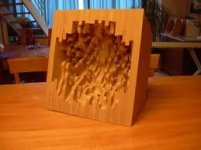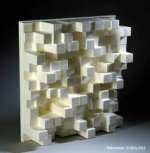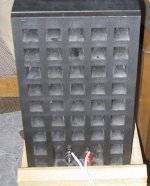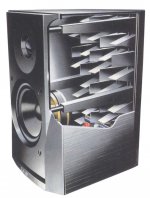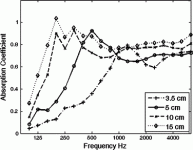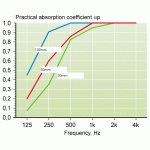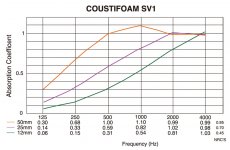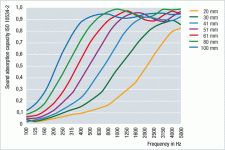Who needs a flat impedance curve anyway?
Amplifiers prefer flat impedances. The happier amplifiers are, the better they control the speakers.
The link says the Neo 8 is in an open back enclosure. I like them already. 🙂
I too believed they were open back (I could not go behind the ones I heard - I did see a black shadow of a grill) but the view rear of cabinet in "A Philharmonic 3 in Ribbon Mahogany" says otherwise.
philharmonicaudio.com
I'd go so far as to mention a finite output impedance, and in some cases stability issues but not the way you seem to suggest.Amplifiers prefer flat impedances. The happier amplifiers are, the better they control the speakers.
The +3dB power into the room manifests itself primarily as reflections and dipole cancellations. The differences would be considerable.I'm thinking of designing an OB to which I can attach a box at the back and so make it possible to switch the design on-the-fly so to speak. What I'm not sure about is how feasible this is - if it's limited to a mechanical design challenge or if making such changes would screw-up the XO design. I want a fixed XO design and have the option of only changing the back.
If it were possible to isolate the dipole effect by running the two options in an very large room for example, you'd get closer to what you're trying to achieve but will still need EQ, and will need to watch the behaviour of the driver under these two differing conditions.
If you believe it is possible to effectively eliminate cabinet resonances, and the back wave in a closed box, then this excercise becomes moot.
Can I suggest you try an experiment. Take a closed box and remove the stuffing. Measure the response nearfield (or almost nearfield where necessary). Keep adding stuffing and measuring looking for a point where you are not measuring a difference.
Member
Joined 2009
Paid Member
Unfortunately, I have no measurement equipment for speaker building - I have a microphone somewhere, a signal generator and an oscilloscope but it sounds like hard work to do much based on this. My measurement system will have to be my ear.
If you change your mind, and you can plug your mic into your computer then you can do it in software.
This is a good suggestion Bigun. It's really amazing how well our ear/brain can adjust input content .. to the point of "illusion" for lack of a better word.If you change your mind, and you can plug your mic into your computer then you can do it in software.
I know Simon, markus, Allen and many others have discussed this very phenomenon briefly in several threads here. It is/can be a real problem when just using one of our senses to determine acoustic quality/accuracy. It takes some real discipline and a degree (emotional) cerebral detachment to have some success using just an ear. ... and your still not 100% sure you got it "right". Very tough. Doesn't take into consideration the point that one might be physically impaired (hearing) either.
Last edited:
Amplifiers prefer flat impedances. The happier amplifiers are, the better they control the speakers.
(ordinary) amplifiers "prefer" moderately high (~10 - ~40ohm) impedances and phase angles close to zero. In reality chasing a flat impedance can make a speaker more current hungry and taxing on the amplifier. Impedance peaks can be your friend, as long as they don't adversely affect passive filter behaviour.
Last edited:
The link says the Neo 8 is in an open back enclosure. I like them already. 🙂
If you ever find yourself in Calgary... come love them 😉 😀
...and yes they are open back. The custom ones can be made with a lid for the back but Dennis designed them as open back with adjustable stuffing. They are well lined to minimize standing waves, and final tuning of the polyfill can be done based on room and placement.
I've been using HOLMImpulse to good effect. Even if you don't have a calibrated mic and anechoic chamber, you can still measure relative changes, and that helps to zero in the changes predicted by modeling software.
For instance, in my latest build, there's a notch in the port output - it looks like the dip in reflex impedance plot. Couldn't hear it at all, but now I know it's there I've been checking for resonant panels and air leaks.
For instance, in my latest build, there's a notch in the port output - it looks like the dip in reflex impedance plot. Couldn't hear it at all, but now I know it's there I've been checking for resonant panels and air leaks.
Member
Joined 2009
Paid Member
I agree, without measurements it's going to be a bit of a crap-shoot. Well, I have an iMac but I haven't seen much in the way of software that I can use with it - maybe somebody here knows ? My son has a Dell lattitude laptop but there's no sign of a microphone input. If there's a thread you can point me to that might help with this it would avoid taking this thread OT ??
I certainly don't have a controlled environment to make measurements, but I'd be able to plan to make measurements outside instead; it would give me a chance to win new friends in my neighbourhood 😀
The more I think about it, the more I'm attracted to the idea of a 'convertible' back for doing some experiments about box colourations.
Leveraging from Stig's InConcert Miles would mean working with a pair of Beyma 15" mid-woofers and a Beyma tweeter. The tweeter is closed back (although the back can be removed this may adversely affect the FR). The XO is around 900Hz. It gives me a set up with 100dB sensitivity which allows me to work exclusively with low powered Class A amplifiers (one being a SET, the other a JLH with nfb).
I could build a stiff front baffle where each mid-woofer was mounted in its own 'U' frame; the optional back(s) would be made to bolt securely onto this 'U' frame. If I arrange the wiring to be part of the front baffle and independent of the back then it could be a fairly simple arrangement, in principle at least, to make quick changes. It might be difficult to separate subjective changes in the Mids from the obvious changes that would occur at low frequencies. And the XO would be a challenge still, it's an area I have no experience with whatsoever.
I certainly don't have a controlled environment to make measurements, but I'd be able to plan to make measurements outside instead; it would give me a chance to win new friends in my neighbourhood 😀
The more I think about it, the more I'm attracted to the idea of a 'convertible' back for doing some experiments about box colourations.
Leveraging from Stig's InConcert Miles would mean working with a pair of Beyma 15" mid-woofers and a Beyma tweeter. The tweeter is closed back (although the back can be removed this may adversely affect the FR). The XO is around 900Hz. It gives me a set up with 100dB sensitivity which allows me to work exclusively with low powered Class A amplifiers (one being a SET, the other a JLH with nfb).
I could build a stiff front baffle where each mid-woofer was mounted in its own 'U' frame; the optional back(s) would be made to bolt securely onto this 'U' frame. If I arrange the wiring to be part of the front baffle and independent of the back then it could be a fairly simple arrangement, in principle at least, to make quick changes. It might be difficult to separate subjective changes in the Mids from the obvious changes that would occur at low frequencies. And the XO would be a challenge still, it's an area I have no experience with whatsoever.
Last edited:
There has been alot of discussion about "boxy" sounds, etc on this thread and OB vs sealed or ported. Only a few have mentioned actual box construction and I am not sure why this isnt a more focused part of the discussion. Alot of people assume that simply using 3/4" MDF with bracing makes for solid construction. MDF is extremely porous, a ton of air can move through it and create all sorts of problems - loss in tightness of bass, dip in impedance, etc.
The porosity of MDF might not be believable until you take look at a CNC machine setup for cutting sheet material. Generally 3/4" MDF is used as a spoilboard - it sits underneath your workpiece so that the CNC tooling doesn't cut through the table itself. A vacuum system sucks THROUGH the MDF to hold down the workpiece. There are no holes cut into the MDF to make this work, it just uses the porosity of MDF to its advantage. When the vacuum is on it nearly impossible to move the workpiece - hundreds of lbs of force through the sheet material with a simple vacuum.
The porosity of MDF might not be believable until you take look at a CNC machine setup for cutting sheet material. Generally 3/4" MDF is used as a spoilboard - it sits underneath your workpiece so that the CNC tooling doesn't cut through the table itself. A vacuum system sucks THROUGH the MDF to hold down the workpiece. There are no holes cut into the MDF to make this work, it just uses the porosity of MDF to its advantage. When the vacuum is on it nearly impossible to move the workpiece - hundreds of lbs of force through the sheet material with a simple vacuum.
The fact is that you haven't factured that the sound passes through the cone , which is transparent .... When the vacuum is on it nearly impossible to move the workpiece - hundreds of lbs of force through the sheet material with a simple vacuum.
It's just a matter of controlling extra excursions at resonance ; and also to prevent extra resonances ,that might radiate from every surface
Member
Joined 2009
Paid Member
I am not sure why this isnt a more focused part of the discussion.
I've been trying....🙂
I have another idea for box construction. I was thinking about what could be done inside the box to reduce the impact of mids reflecting of cabinet walls and I'm wondering if a scaled down diffusor wouldn't provide some benefit when combined with absorption.
Attachments
Attachments
Facts on acoustic absorption
Since most of this discussion seems to be centered on the absorption of internal cabinet reflections or standing waves, let me give you guys some ideas to think about. I've attached a couple of graphs showing absorption quality vs. material thickness. These are for some high quality foam absorbers and the usual rock wool and fiberglass.
As you can seen material thickness is key for a low absorber cuttoff. Every time you double absorber thickness you achieve an extra Octave better performance. We might just put a 2" material lining around the inside of our cabinet and see that anything above the 500 to 800 Hz range is over 90% absorbed. Is that good enough?
It turns out that we need to absorb down to the 1/2 wavelength of the longest dimension. A closed box will have 1/2 (and 3/2 and 5/2) wave resonances for every dimension (LWD) so the most difficult one to absorb is the 1/2 wave of the longest dimension. If we are thinking about a 40 inch tall tower cabinet it would resonate at about 170Hz. Looking at these graphs I can see that about 200mm or 8 inches of these materials would be required.
That turns out to be about 1/5th of the cabinet height. In fact, for any cabinet length or height that we can think of, as the cabinet gets longer the depth of treatment will also grow exactly in proportion, so we can simply state that an end of cabinet depth of treatment of 1/4 to 1/5 the wavelength of the particular dimension will always be needed but will also always be sufficient.
It also turns out that less material will suffice if it is spaced off the boundary. Architectural acousticians know this and save money by spacing absorbers off of the wall and ceiling. Many architectural materials will give data for "E400" mounting. This is the absorption quality of a material spaced 400 mm above a hard surface, which is the average spacing for a drop ceiling below a true ceiling. Such measurements are usually pretty close to having the qualities of the full 400 mm of material but at a considerable cost savings. So our 50 or 100mm material might work pretty well if we space it 1/4 wavelength off of the bottom or back wall (always 1/2 way down the cabinet).
I'm talking about real absorptive materials such as Rock Wool and Fiberglass, not BAF or Dacron pillow stuffing that have near zero absorption.
In the end it isn't hard to absorb the internal acoustical waves in a speaker cabinet if we use the right materials and take care. Airborne and structural born cabinet vibrations are another matter and perhaps we should be concentrating on them more as they are more likely to cause cabinet colouration.
David S.
Since most of this discussion seems to be centered on the absorption of internal cabinet reflections or standing waves, let me give you guys some ideas to think about. I've attached a couple of graphs showing absorption quality vs. material thickness. These are for some high quality foam absorbers and the usual rock wool and fiberglass.
As you can seen material thickness is key for a low absorber cuttoff. Every time you double absorber thickness you achieve an extra Octave better performance. We might just put a 2" material lining around the inside of our cabinet and see that anything above the 500 to 800 Hz range is over 90% absorbed. Is that good enough?
It turns out that we need to absorb down to the 1/2 wavelength of the longest dimension. A closed box will have 1/2 (and 3/2 and 5/2) wave resonances for every dimension (LWD) so the most difficult one to absorb is the 1/2 wave of the longest dimension. If we are thinking about a 40 inch tall tower cabinet it would resonate at about 170Hz. Looking at these graphs I can see that about 200mm or 8 inches of these materials would be required.
That turns out to be about 1/5th of the cabinet height. In fact, for any cabinet length or height that we can think of, as the cabinet gets longer the depth of treatment will also grow exactly in proportion, so we can simply state that an end of cabinet depth of treatment of 1/4 to 1/5 the wavelength of the particular dimension will always be needed but will also always be sufficient.
It also turns out that less material will suffice if it is spaced off the boundary. Architectural acousticians know this and save money by spacing absorbers off of the wall and ceiling. Many architectural materials will give data for "E400" mounting. This is the absorption quality of a material spaced 400 mm above a hard surface, which is the average spacing for a drop ceiling below a true ceiling. Such measurements are usually pretty close to having the qualities of the full 400 mm of material but at a considerable cost savings. So our 50 or 100mm material might work pretty well if we space it 1/4 wavelength off of the bottom or back wall (always 1/2 way down the cabinet).
I'm talking about real absorptive materials such as Rock Wool and Fiberglass, not BAF or Dacron pillow stuffing that have near zero absorption.
In the end it isn't hard to absorb the internal acoustical waves in a speaker cabinet if we use the right materials and take care. Airborne and structural born cabinet vibrations are another matter and perhaps we should be concentrating on them more as they are more likely to cause cabinet colouration.
David S.
Attachments
Last edited:
Bigun,
dipole bass
or even cardioid bass (open back box)
requires LF drivers that are much more efficient than the mid/tweeter in a passive set up.
remember that stig was using several 21" woofers per 1 beyma tpl and his was an active set up.
if you are to use open/closed box alternately with the same drivers, you will have to go active at least with the woofers (plus equalization ideally).
dipole bass
or even cardioid bass (open back box)
requires LF drivers that are much more efficient than the mid/tweeter in a passive set up.
remember that stig was using several 21" woofers per 1 beyma tpl and his was an active set up.
if you are to use open/closed box alternately with the same drivers, you will have to go active at least with the woofers (plus equalization ideally).
Last edited:
Member
Joined 2009
Paid Member
SpeakerDave, those are some useful guidelines that all of us should be ably to apply. Any opinion on the effectiveness of bublewrap and pacaking 'peanuts' for absorbing material ?
yeah, I've been mulling that over. The parts cost for Stig's builds are universally very high. So I am considering the option of starting with a single Audio Nirvana 15" driver instead. This allows me to do some experiments at less cost, it also eliminates the mid-band XO and so reduces the 'variables'.
Bigun,dipole bass or even cardioid bass (open back box) requires LF drivers that are much more efficient than the mid/tweeter in a passive set up. remember that stig was using ...
yeah, I've been mulling that over. The parts cost for Stig's builds are universally very high. So I am considering the option of starting with a single Audio Nirvana 15" driver instead. This allows me to do some experiments at less cost, it also eliminates the mid-band XO and so reduces the 'variables'.
Last edited:
Lining the cabinet with the best aborbing material (like fiberglass) will not completely kill all internal reflection. There is a reason anechoic chambers have fiberglass wegdes, and not plain fiberglass.


SpeakerDave, those are some useful guidelines that all of us should be ably to apply. Any opinion on the effectiveness of bublewrap and pacaking 'peanuts' for absorbing material ?
I'm sure that peanuts and bubble wrap absorb a little, but nothing near what proper acoustical meaterials would.
I have never seen anything that measures with better absorption than acoustical grade fiberglass and its near equivalent, rock wool. When architectural acousticians need a material that works (effectively absorbs sound in a classroom, shopping mall, office building, public building) that is what they use.
Plus they are as near as your local Home Depot.
David S.
Lining the cabinet with the best aborbing material (like fiberglass) will not completely kill all internal reflection. There is a reason anechoic chambers have fiberglass wegdes, and not plain fiberglass.
Two reasons: a possible slight high frequency reflection that is improved by allowing the sound to bounce off the surfaces and down into the wedges, and it cuts the required material in half.
I think the first factor has much to do with varnished or covered surfaces used for wedge durability.
It means nothing to us in loudspeakers because we don't have high frequency issues internal to the cabinet (2 way crossovers keep HF out of the woofer enclosure, plus woofers are a good HF barrier).
In any event it is the best you are going to do. Going open back or TL or H frame will give dramatically more radiation into the room from the back of the cone.
David S.
- Home
- Loudspeakers
- Multi-Way
- Box colourations - really ?
